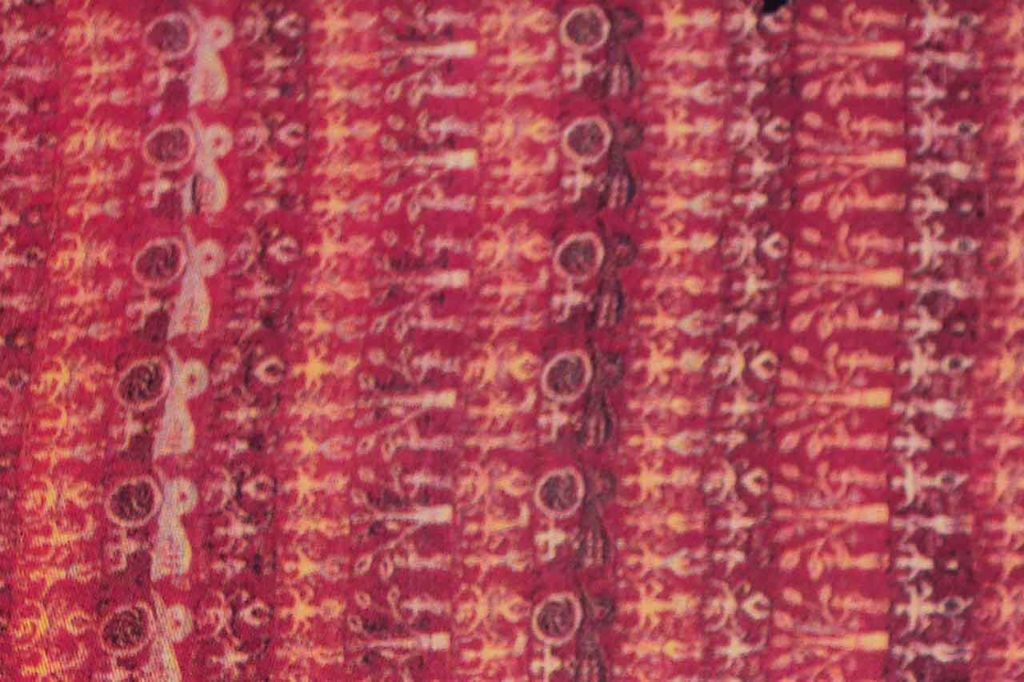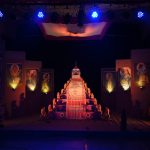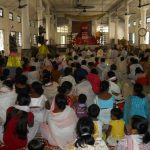Srimanta Sankaradeva is generally remembered as a religious preceptor, who founded the Eka Sarana Nâma Dharma order. But that is not his only identity. His activities were not confined to the realm of religion alone. His activities were multi-dimensional. He contributed so many things to the society, or to be more precise to the humanity. He created many new things, new type of building structure, new social structure, new type of social management, new educational system, new food, new health care, new musical instrument, new music, new dance form, new form of play, new form of textile art, new form of painting and so on. There was innovation in almost all his activities. Very often he did not follow the beaten track. He charted his own path. His new path was always so attractive and suitable that people soon started to follow him in the new path.
Nâmghar is a great institutional structure innovated by Srimanta Sankaradeva. It was the central unit inside the residential institution Thân (later known as Sattra) created by him. Also known as Kirtanghar, especially in the Sattra, Nâmghar is the most important contribution of Srimanta Sankaradeva to the society. It functions as both prayer hall and community hall. Even cultural items like plays are performed inside it. Social litigations are solved by the villagers in an assembly within this hall. Little wonder, Nâmghar became an indispensable part of every village, where Eka Sarana Nâma Dharma took root. The multi-dimensional role of this institution has thus played an important role in elevating the standard of socio-cultural lives in Brahmaputra valley. Apart from the multi-dimensional function of the Nâmghar its architecture is also quite distinctive, which signifies its innovative nature. In no other prayer hall in Sanâtana religion one sees the openness like in Nâmghar. It is not made of stone like the temples. The altar inside the prayer hall known as Guru-âsana speaks volume about the creativity of Srimanta Sankaradeva and his followers.
Srimanta Sankaradeva was quite innovative in food too. He introduced sugar in the Brahmaputra valley. His health consciousness made him explore new ways to ensure good health among people. So he introduced an innovative offering during the prayer sessions. The Prasâda served to the devotees after community prayer is a unique balanced food with numerous ingredients for protein, digestion, anti-oxidant etc. Srimanta Sankaradeva also advised people to live in hygienic way. When people fell ill, he prescribed Ayurvedic remedies. He cured a nephew of tuberculosis by advising him to live in a clean hut surrounded by basil plants. It has now been proved that basil leaves cure tuberculosis. He was a pioneer in environmental protection too. He said that one tree was equivalent to ten sons.
The Ankiyâ plays of Srimanta Sankaradeva happened to be a great cultural innovation. Started with Chihna Yâtrâ in 1468, these plays initiated a new form of play in Bhâratavarsha. Elevated stage and dop-scene were two major innovations in this Ankiyâ play. This new genre of play came away from the tradition of Sanskrit plays where the Sutradhâr had used to be a minor character. Contrary to that, the Sutradhâr in Srimanta Sankaradeva’s Ankiyâ plays played the role of anchor vigorously, without making exit from the arena. Wedding, battle and such other acts which were prohibited in Sanskrit plays were incorporated in Ankiyâ plays. Costumes of different characters were also designed by Srimanta Sankaradeva in a new fashion with ethnic ingredients. He also introduced children character in his play Patni-Prasâda, which was a pioneering exercise. Never before in the history of drama, children character had been included in any Indian play.
The Ankiyâ plays were the breeding ground of a new form of classical dance, now known both as Sattriya Nritya and Sankari Nritya. Postures like Tribhanga are special features of this dance form. Srimanta Sankaradeva created this dance and trained the first batch of danceuse himself. The grammar of this dance is taught in Mâti-âkhorâ which was characterised by elements of several Yogâsana. The hand and feet movements of Sattriya Nritya or Sankari Nritya were also innovated by Srimanta Sankaradeva from indigenous elements; one can see traits of Bodo dance, Mising dance etc in it.
The Ankiyâ plays were also the breeding ground of a new form classical music. Srimanta Sankaradeva was a genius in the field of music. He inherited it in his blood. He predecessors were maestros of Vedic music. They had practised Vedic music in Kannauj, till their migration to the eastern part of Bhâratavarsha following political upheaval in Northern part of Bhâratavarsha. Srimanta Sankaradeva did more research on this branch of music during his twelve year long first pilgrimage. It was mostly as a result of this research and heritage that Srimanta Sankaradeva composed his own style of music, which we venture to call Sankari Sangeet. The first example of this music was presented in Chihna Yâtrâ. Srimanta Sankaradeva used a few Râgas composed by him in this play. Throughout his life he created twenty five Râgas.
The most distinctive component of Sankari Sangeet was Bargeet, the prayer songs highlighting the attributes of lord Krishna and the glory of devotion to him. The Râgas of Sankari Sangeet are different from Hindustâni Sangeet and Carnâtic Sangeet. The Sankari Sangeet carries the flavour of Vedic Sangeet, while the other two forms of classical music were later day creations, Hindustâni Sangeet even having ingredients from outside Bhâratavarsha like Persia. But the notable point is that even though Sankari Sangeet derives its origin from Vedic Sangeet, it is completely new creation of the maestro. It was only revival of ancient Dhruva Sangeet tradition of Vedic time, but the ingredients were Srimanta Sankaradeva’s own. For example there are ingredients of ethnic music of Tiwa, Ahom etc. Such experimentation were done in case of music used in devotional prayers like Prasanga and Nâma Kirtana also. Thus Sankari Sangeet was quite innovative. It can be called a pioneering attempt in fusion too. But the blending was done in such a fine manner that the folk components were elevated to classical level, not the other way round. It was thus that the tunes of Lâli-hilâli of the Tiwa people were incorporated in Bargeet.
In musical instruments also Srimanta Sankaradeva displayed his great innovativeness. The drum Khol was his contribution to the realm of classical music. He created this drum, which looked like an amalgamation of the two parts of Tablâ joined together, during the preparation for enactment of his maiden play Chihna Yâtrâ. The accoustic property of Khol is different from Mridanga, its nearest kin. The sound of Khol is much more husky, resonant and deep than that of Mridanga. This made it more appropriate for rendering of Bargeet, which is characterised by wide variation in scale than other classical songs. But this was not the only innovation in the spehere of musical instruments. Srimanta Sankaradeva also introduced big cymbals called Bhortâl. It was an improvement on the brass-made dual plates used among the ethnic groups in Himalayan belt. He introduced Dobâ (kettle-drums) in the community prayers, which endowed a deep spiritual feeling to the renderings. The beating of Dobâ amounted to a clarion call too. It was beaten at fixed hours to exhort the devotees to come for community prayer. Later it began to be used for exhortation to social purposes too, which highlights the influence this instrument has had over the psyche of people.
A cultural maestro, Srimanta Sankaradeva knew that people needed cultural food just like physical food. In addition to his serious classical creations he introduced festivals where mass people could participate. One such festival was Holi. It was he who popularised this festival in Brahmaputra valley. He added a Vaishnavite hue to it and made it part of his religious activities. Over time other prevailing festivals like Bihu also incorporated Vaishnavite elements from his order. Such elements conferred longevity to his order, which continues to flourish even now. In fact this trend started with his very first initiative, the Chihna Yâtrâ. That was more of a festival than a play. Certainly that was an innovative act of Srimanta Sankaradeva which not only enthralled the audience but also attracted many of them to his ideology.
The concept of Bhâratavarsha as described by Srimanta Sankaradeva in his writings is also very unique. It was a cultural concept, not a political concept. He eulogized Bhâratavarsha in so many places of his writings that it cannot be overlooked or termed as accidental. He promoted the concept of Bhâratavarsha deliberately. He said that to take birth in Bhâratavarsha happened to be a boon. He termed the birth in Bhâratavarsha as a great fortune for one’s spiritual elevation. That clearly negated any political boundary for his Bhâratavarsha. The ancient heritage of the Vedas and the epics determined his Bhâratavarsha. It was thus a religio-cultural heritage that he wanted to convey. This was quite innovative for a litterateur. He also introduced textual criticism in this part of Bhâratavarsha, as seen from his classic work Bhakti-Ratnâkara. As a litterateur he made many experiments. The foremost among them was the use of Brajâwali which was taken from a prevailing dialect. While some of his works were written in chaste Assamese, the Bageet and the Ankiyâ plays were written in a prevailing local dialect, which came to be known as Brajâwali over time. It endeared these creations to people and also made it understandable to people of North India, as their dialects were also very similar to this one. This experiment was to some extent similar to that of Charyâpada centuries ago; that was why Charyâpada had become a common heritage for several groups of people. The popularity of Srimanta Sankaradeva’s Kâliya-damana play in Bengal can be understood from that linguistic perspective. Brajâwali still survives in dialect form western Assam in the so-called Goâlpariyâ dialect.
Srimanta Sankaradeva was a pioneer in the field of education also. Adult education and non-formal education were two major elements embedded in his plays and hymns. All his literary works had the contemporary curriculum of the residential school Tol as content. So whenever an Ankiyâ play was enacted or a hymn sung inside the open Kirtanghar, the entire populace including the elderly population got to hear and thereby learn those things. That was how people learnt to be wise, even though they did not earn any formal degree. Those among the villagers who joined the Eka Sarana Nâma Dharma order, were fortunate to learn dance, music etc also. Some of the devotees were trained in manuscriptology too. They were trained in making crafts. Thus the Thân or Sattra became an educational institution too. While similar religious institutions had always been imparting religious education, there had never been such an integral approach covering secular cultural elements like dance, music, plays, crafts etc elsewhere as in Thân or Sattra. Self-dependent nature was another feature of this institution. Making one’s own living was an imperative for everyone living in it. Its management style also was unique, with decentralisation in every step. It was certainly a great innovation. The institution Thân or Sattra thus became the path-breaking innovation in the second millennium. It went beyond the Kibbutz of Israel or Commune of China. No wonder, it still survives.
[Enlarged version of the key-note address delivered in the International Seminar on Srimanta Sankaradeva organised by Mahapurusha Srimanta Sankaradeva Viswavidyalaya at Nagaon on February 25, 2017]




